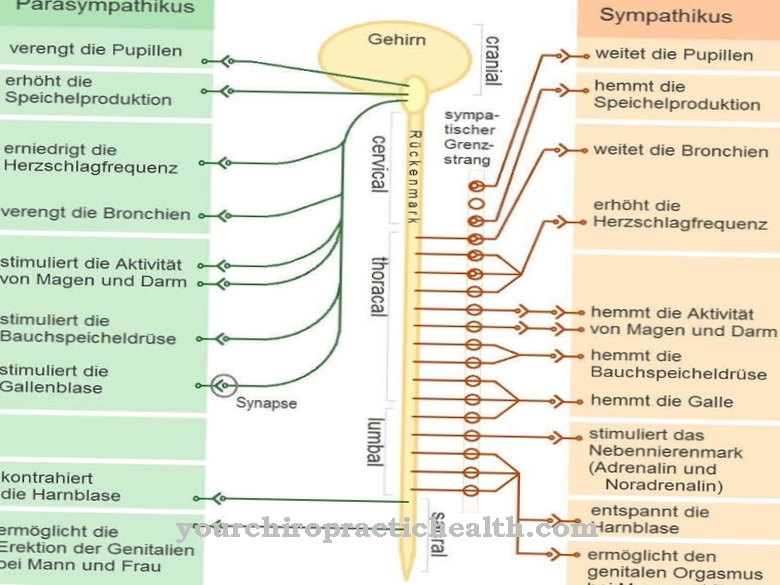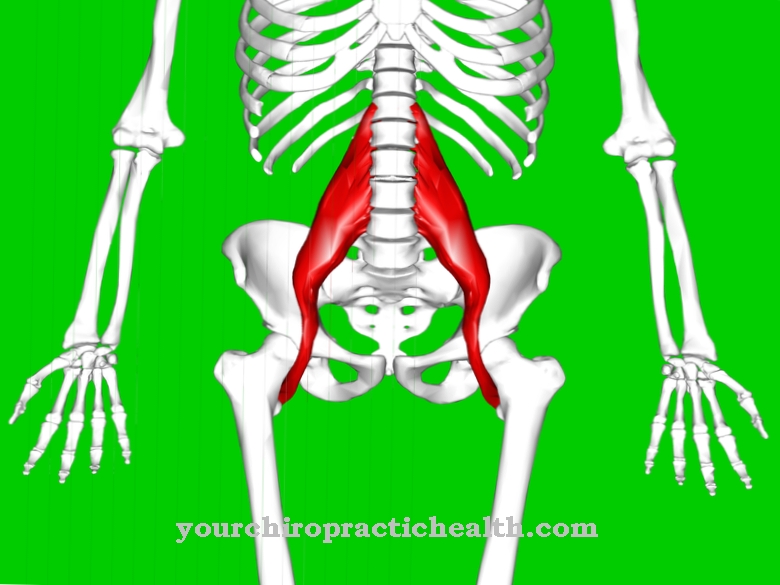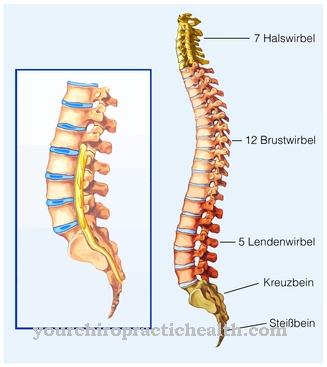Of the Longissimus muscle spans the entire back and is one of the local back muscles. The skeletal muscle is primarily responsible for straightening the spine and consists of three different parts. Various incorrect postures are associated with the longissimus muscle, especially lordosis.
What is the longissimus muscle?
The back muscles consist of different parts. In addition to the auxiliary muscles, the autochthonous back muscles should be mentioned in this context. The autochthonous back muscles in turn contain the sacrospinal system, which is built up from the muscles longissimus cervicis, longissimus capitis and longissimus thoracis.
Together these three muscle parts form the entity of the longissimus muscle. In the medical literature there is sometimes talk of a fourth muscle component, the so-called longissimus lumborum muscle. However, other authors interpret this part of the muscle as part of the iliocostalis muscle. This assignment problem basically fits the local back muscles, the individual entities of which are difficult to differentiate.
The longissimus muscle is also known as the erector spinae muscle, which literally means “erector of the spine”. Together with other back muscles, it forms the epaxial trunk muscles. The innervation of the skeletal muscle is carried out by the posterior rami of the spinal nerves, depending on the segment.
Anatomy & structure
In humans, the longissimus muscle extends over the entire back and extends from the sacrum to the head. The skeletal muscle is located between the iliocostalis and semispinalis muscles, with which it forms the erector spinae muscle and the epaxial trunk muscles.
The longissimus muscle lies with each of its parts on the back of the transverse vertebral processes. The part of the musculus longissimus thoracis originates from the facies dorsalis on the os sacrum. In addition, the spinous processes of the lumbar vertebrae and the transverse processes of the lower thoracic vertebrae are considered the region of origin. The portion of the longissimus cervicis muscle, on the other hand, originates from the transverse processes of the first to sixth thoracic vertebrae.
For the longissimus capitis muscle, the transverse processes of the third cervical vertebra up to those of the third thoracic vertebra are the origin. The longissimus thoracis muscle attaches to the transverse processes of the thoracic spine and lumbar spine. On the lumbar spine, the second to twelfth ribs between the angulus costae and tuberculum costae are considered to be the starting point. For the longissimus cervicis muscle, the posterior tuberosity on the second to seventh cervical vertebrae is considered the attachment. For the longissimus capitis muscle, it is the mastoid process.
Function & tasks
The longissimus muscle performs different functions in the human body. All of these are motor functions that are more or less concentrated in the area of the back. Like any muscle, the longissimus muscle is to be understood as a neuromuscular unit made up of muscle tissue and the nerve structures that supply it. Ultimately, therefore, one cannot speak directly of the functions of the longissmus muscle.
More correctly it should read "the functions of the neuromuscular entity consisting of the longissimus and posterior rami muscles. Since the muscle consists of three different parts, its motor functions can be broken down into three parts. The longissimus thoracis muscle part is responsible for extension and sideways inclination in the thoracic and lumbar spine. We are also talking about the extension and dorsiflexion of the thoracic and lumbar spine, whereby the expiration is also supported by the muscle part. The longissimus cervicis part has similar tasks. Its contraction causes dorsiflexions and lateral inclination in the cervical and thoracic spine.
The longissimus capitis muscle in turn triggers dorsiflexion, rotation and lateral inclination of the head and cervical spine through its contraction. In principle, the bilateral contraction of the longissimus muscle causes the spine to be straightened or stretched while the neck is raised. The one-sided contraction, on the other hand, is responsible for the sideways tilt of the spine. The muscle receives the commands to contract from the central nervous system.
The commands from the central nervous system in the form of action potentials reach the motor endplate on efferent pathways, where they are transmitted to the muscle. Sometimes the most important symptom of lordosis is the so-called curvature of the abdomen, which in this case points in the ventral direction.
You can find your medication here
➔ Medicines for back painDiseases
The individual parts of the longissimus muscle, like all other muscle parts, can be affected by tension, improper strain, cramps, inflammation and other muscle diseases. In addition, lesions on the supplying nerves as well as central lesions in the area of the spinal cord can paralyze the muscle or its parts.
Trauma, tumors, compression, or inflammation can be responsible for such paralysis. Diseases of the peripheral or central nervous system can in principle cause paralysis of the muscle. The longissimus muscle is associated with pathological phenomena such as lordosis and scoliosis far more often than with paralysis. The lordosis corresponds to a forward curvature of the spine. In scoliosis there is a lateral deviation of the spine. These bad postures can be traced back to individual conditions of the longissimus muscle.
A trigger for a hollow back in the sense of a lordosis can, for example, be insufficiently trained and therefore hypertonic back muscles due to lack of exercise, which no longer relax properly. Especially in later stages, lordosis leads to more or less severe back pain and can also favor secondary diseases such as a herniated disc or the phenomenon of sliding vertebrae. For this reason it is important to prevent lordosis. In addition to back training, detonation techniques, relaxation techniques and a balanced training of back and abdominal muscles are also preventive measures.



























